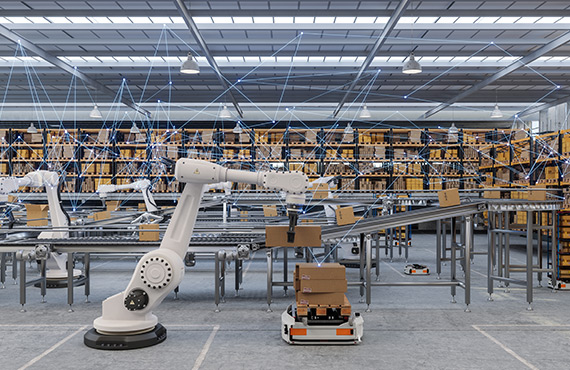
The manufacturing industry is currently undergoing a tremendous transformation. The main goal is to improve performance.
Automation has been a crucial part of manufacturing for many years. But, recent advancements in artificial intelligence and machine learning have taken process control to new levels. Smart automation uses data and analytics to give new insights into operations.
Process automation offers manufacturers significant competitive advantages. Real-time monitoring, predictive maintenance, and adaptive control streamline operations. They also make them safer, more flexible, and cost-effective. This enables organizations to maximize uptime, increase yield, and cut waste.
Let's delve into the present scenario of intelligent process automation in this article. We'll uncover the cutting-edge technologies that drive smart control systems.
The Evolution of Process Control Systems
The Evolution of Process Control Systems has been a remarkable journey. In the early 20th century, people did everything manually . Operators had to keep an eye on temperature, pressure, and flow rates. They made adjustments by hand. It was a laborious, imprecise, and hazardous task.
But then came the 1930s, and with it, the introduction of pneumatic controls. Using compressed air, operators could remotely operate valves and actuators. This brought some automation to the process.
The real game-changer arrived in the 1950s with the advent of electronic controls. Analog electronic circuits enabled closed loop feedback control.
Fast forward to the 1970s. Microprocessors and computers revolutionized the field, birthing distributed control systems (DCS). These systems allowed for centralized monitoring and control of many interconnected process units.
In the 1980s, programmable logic controllers (PLCs) emerged. They brought automated sequences and interlocks into the picture. The evolution of process control systems has been a remarkable journey. It has transformed industries and made operations more efficient and safe.
In the 1990s, the majority of prominent process industries made the shift towards computer-based automation.
Present-day smart control systems use extensive data, sophisticated algorithms, and integrated software to revolutionize efficiency, quality, and safety.

The Rise of Smart Automation
In the past, older systems relied on predefined rules and programmed logic. Today's smart systems can analyze data, recognize patterns, and make optimized decisions independently. This advancement has opened up a whole new realm of intelligent process control.
There are several key advantages to smart automation:
- Handling more data from sensors and instruments.
- Improving performance by learning from past operations.
- Adjusting control parameters to adapt to changes.
- Predicting potential issues before they occur.
- Making control actions more precise and nuanced.
- Optimizing the entire system holistically, rather than individual components.
Powerful AI/ML technologies are driving the transition to smart automation. Affordable sensors provide vast amounts of data. Robust industrial computing power also contributes.
Smart automation brings significant performance improvements. It also unlocks new capabilities that were previously unimaginable. Systems can now self-adjust, detect anomalies, put in place complex strategies, and optimize.
Key Technologies Powering Intelligent Process Control
Intelligent process automation uses cutting-edge technologies. It eases real-time monitoring, analysis, and automated management of industrial processes.
They include:
- Sensors:
- Process sensors provide up-to-the-minute data on critical parameters. These include pressure, temperature, flow, level, and vibration. This allows for constant feedback loops and adjustments by the control system.
- Smart sensors have the ability to communicate readings over networks, enabling seamless integration. Additionally, wireless sensors have emerged, reducing wiring costs and complexity.
- Advanced sensors, like gas chromatographs and spectroscopy analyzers, can even detect chemical composition. This ensures quality control.
- Industrial Internet of Things (IIoT):
- The IIoT connects sensors, devices, and equipment through networks. This allows for the aggregation of sensor data. This provides a comprehensive view of the entire production environment.
- Big data analytics can analyze machine data. This enables identifying inefficiencies, predicting failures, and optimizing performance.
- Data Analytics:
- Machine learning algorithms can uncover hidden insights and patterns within vast amounts of process data. This facilitates predictive analytics.
- Anomaly detection identifies deviations from normal operations. This allows for timely issue resolution before problems escalate or cause downtime

Edge Computing
By conducting computing and analytics at the "edge" of the network, we can reduce latency. This allows us to make real-time process adjustments. This means we process data on-site instead of waiting for it to travel to central/cloud systems. It results in faster response times.
Further, edge computing also helps in reducing bandwidth requirements. We can process raw data locally.
When combined with IIoT infrastructure, edge computing takes process control to a whole new level. It lets us have more responsive, resilient, and intelligent control over our processes. With edge computing, we can make informed decisions and take immediate actions.
Real-Time Monitoring and Predictive Analysis
Today's advanced smart process automation systems offer operators a valuable tool. They offer real-time monitoring capabilities. These provide a comprehensive view of all facility operations. Advanced sensors equip these systems.
This data is then fed into intelligent software platforms. The platforms detect anomalies or potential equipment failures before they even happen.
Thanks to the integration of machine learning and artificial intelligence, these predictive maintenance systems can learn the normal operating parameters for each asset. This allows them to identify even the slightest changes.
This shift from reactive to proactive maintenance is crucial for maximizing productivity. Studies have shown that predictive maintenance can reduce unexpected outages by up to 70%. It can also lower maintenance costs by 25% or more.
But, that's not all.
Today's smart automation systems also come with intuitive dashboards. They provide personnel with real-time status updates on any process variable.
With full visibility into all operations, companies can optimize production.
Automate Complex and Hazardous Processes
Industries such as chemical manufacturing, oil and gas, and utilities face the challenge of dealing with high-risk processes. They must demand precision and control.
By automating these complex and hazardous operations, you can achieve these significant advantages:
- Automation systems cut direct exposure to hazardous environments, enhancing operator safety. They ensure increased safety for operators. They can check and control processes that involve toxic materials, extreme temperatures, and high pressure.
- Reduce risk through continuous monitoring. Automation provides real-time data and insights into process conditions. This enables early identification of risks and abnormalities. Predictive analytics further enhance risk management capabilities.
- Automated systems execute procedures exactly as designed. This eliminates human error and variability, improving quality and consistency. This ensures that operations adhere to safety protocols and quality standards.
The latest automation solutions manage processes with zero tolerance for deviations. For example, advanced process control (APC), automated safety systems, and remote operations.
Achieve Higher Efficiency, Agility and ROI
Intelligent process automation revolutionizes industrial operations. It delivers tangible improvements in efficiency, productivity, quality, and safety.
Let's explore the key advantages:
- Companies can reduce operational costs by implementing predictive maintenance and optimized control strategies. This includes minimizing downtime and cutting energy and material expenses. It results in potential savings of 20-30%.
- Automation takes care of repetitive tasks and complex processes. This leads to a remarkable 15-25% increase in output.
- Advanced monitoring and control heighten product quality. They make products more consistent. This translates to less waste and rework, reducing defects by up to 40%.
- Enhanced safety: Automating hazardous tasks reduces the risk exposure for workers. Furthermore, predictive analytics play a crucial role in improving safety.
- Improved sustainability: Optimized processes contribute to a greener future. They reduce energy use, emissions, and material waste. Companies can make a significant impact by reducing their carbon footprint by 10-20%.
- Increased agility: Flexible and self-adjusting automation systems empower companies to adapt to changing demands, input variabilities, and new products.
- Intelligent automation proves to be a wise investment, providing a high return on investment. It brings a rapid ROI. Companies witness payback within 12-18 months as the quantifiable benefits accumulate.
The evidence is clear.
Smart process control delivers large gains in productivity, quality, safety, and sustainability.
Implementing Advanced Process Control Systems
The integration and implementation of these innovative technologies need meticulous execution.
Here are some important factors to consider:
- Assess operational objectives and pain points. It is crucial to identify the current operational challenges. It is also crucial to identify inefficiencies, safety risks, and quality control issues.
- Audit existing infrastructure. Take stock of the legacy process control hardware and software systems in use. Identify any compatibility issues or upgrade needs.
- Conduct Proof of Concept Trials. Start with a limited pilot deployment of the new process control technology. Focus on a single unit operation or workflow. Gather performance data and feedback from operators. Use this information to refine the system before a wider rollout.
- Implementation in stages: Begin by implementing the new systems in less critical processes. Then, move on to core production lines. This approach allows time for training and adjustments, ensuring a smooth transition.
- Maintain open communication. Keep stakeholders and staff informed and engaged through regular project updates and training sessions. Ask for operator feedback to improve workflows and fine-tune control parameters.

The Future of Process Automation
The future of process automation holds immense potential. New advancements continue to push the boundaries of efficiency, agility, and control.
Here are some emerging trends that are set to revolutionize industrial operations:
- Companies will adopt AI and machine learning to increase the predictiveness and autonomy of processes. By analyzing data, systems will detect patterns, predict outcomes, and recommend optimal actions. This paves the way for "lights out" operations with minimal human intervention.
- Digital twins and simulations will see wider usage. Virtual models can test various scenarios before implementing changes in the real world.
- Advancements in computer vision, vibration monitoring, and other sensor technologies will provide unparalleled visibility into all aspects of operations.
- Industrial control systems will be further integrated with ERP, MES, and other platforms. This integration breaks down silos between OT and IT, facilitating faster information sharing.
